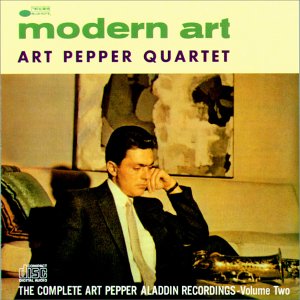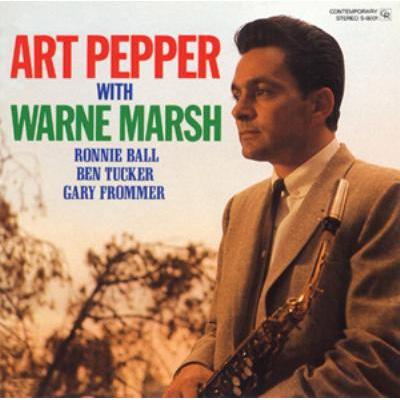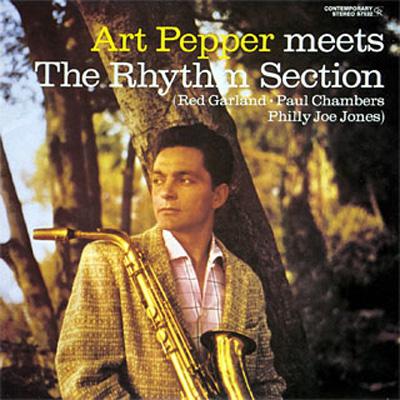|
Art Pepper is born in 1925-1982 Gardena,
California Art Pepper is said to belong to a group called so-called West
Coast school. Their characteristics are not sounds that come to be
heard from the darkest jazz clubs in New York, but as if it were a clear
blue sound like California's blue sky. The images associated with white
jazz players like Pepper have features that are different from the image
of black players in the sense of comparison. If the difference is
extremely simplified, "feeling shabby / heavy feeling" "lightness /
stickiness" "skillful / individuality" "emphasis on ensemble / emphasis on
ensemble". Generally speaking, it can be said that the lightness and
lightness is a kind of mind, which emphasis on ensemble by technical,
tendency as a tendency, it applies to the image which heard Pepper's
play.
Modern
Art 1956年12月12月28日録音 Bewitched When You're Smiling Cool Bunny Diannes' Dilemma Stompin' At The Savoy What Is This Thing Called Love Blues Out Art
Pepper (as)
Russ Freeman (p) Ben
Tucker
(b) Chuck Flores (ds) If you stopped reading the explanation here, you may be
misunderstood the Art
performance as a BGM-like content empty enough for
ear-perception. But at the bottom of the superficial lightness of
Pepper's performance, there is a creative improvisation that can not
be imitated by other players. As soon as entering ad lib from the
familiar melodic theme, there is a dreadful play that is hidden in
the bottom of a light sound that destroys the original song. It is
based on a different methodology from Charlie Parker, and the
characteristic of Pepper is that it plays lightly at first glance,
without appealing it as "terrible thing", and a code with a major
code as a base It is in a place that does not become serious in
progress. You will be taken to an unexpected place while idly
listening to the tasteful performance of Pepper. It's like a fairy
tale of Hameln's whistling. And Pepper has a place to insert a minor
tone melody like spice, in some places in its rich improvising
phrase, makes you feel strongly the shadow's beauty, letting you
listen to your emotions as plenty of thought. That is, beauty of
drawing, so to speak. So, once you have heard it, you are full, not
many more, you will never get tired of listening
repeatedly. His activity period is long, but after playing active
in the 1950s, there was a blank after drowning in drugs for a while,
and after the comeback in the 1970s the shadow's beauty is said to
have transformed into a powerful play with a shadow
hidden. I would like you to listen to the slow blues played
only by the two people, Ben Tucker and Art Pepper, at the beginning
and end of the album. Although this song titled "Blues In" "Blues
Out" is stylish, there is almost no theme thematic theme, and from
the beginning to the end he is playing with ad lib. He is competing
only with ad lib for 6 and 5 minutes, which is the performance time
of each song. Besides, these songs are just too simple, just two of
the bass and saxophone, almost everything is his saxophone solo. So,
the saxophone he plays does not blow at all with the feeling of
belly, and does not use Keren who blows a blow with the sound of a
light touch, nor does it sing a melody as a cotton . If you write
like this, you will understand his performance as though it were
uncharacteristic. You may think that his performance is "Wabi,-Sabi"
in Zen. That is not a mistake. Strongly speaking, his saxophone has
elements that lead to this song of Shakuhachi(a five-holed bamboo
Japanese flute). What is common to both is that it has a deep taste
with a tense feeling though it is apparent at first sight. In a
performance like a simple extreme like sharpening that emptiness,
Pepper makes use of his delicate, shadowy nuance, which is the true
verb. He never gets loudly, but rather his play close to the
suppressed weak tone remembers the illusion that he is listening to
the human voice as various sounds and touch. If you listen to his
performance, the other player's saxophone sounds like a monotone. In
other songs in this album, it changes to a formation that piano and
drums are added, but the whole tone is consistent. For those two songs only, I would like to listen
repeatedly in a quiet room in my room, not listening in the hot
live. It is closer to listening to classical music, rather than
being impressed by Beethoven's intense music, submerged in Chopin's
delicate music. Let's listen to the album. The first "Blues In" is
an improvised solo that has been stretched for six minutes to stuff.
In "Bewitched" Freeman's bright piano intro is a light catharsis
that can open up as if it were sight. Pepper's saxophone that
follows the piano is as light as feathers grow. Here, Pepper When
you blow the one chorus first, after that, play an ad lib phrase as
if it blossomed like a blossoming blossom. His ad - lib 's flashing
spirit is excessive, and the melody of the theme is broken. Pepper
seems to be holding it hard. Even if I listen to it, I do not feel
like I'm consciously breaking down such as "Let's like this". He is
not exaggerating, he is playing saxophone while keeping his mind
"without losing your mind" as if it were a deluge. However, there is
another awakening pepper, which also controls the "connection with
the theme melody". I feel that way. His creation of such a tension
that such control gets stuck is made. With the next song "When
You're Smiling", he raises the tempo a little. Pepper plays the sax
to make it run lightly, with a theme that closely resembles the
melody of "Make a dance all night" of the musical "My Fair Lady". In
the next "Cool Bunny", he will raise the tempo further and he will
play saxophone at high speed. However, he never escalates the
performance. Speaking of piano, it is a feeling of pressing
shallowly without pushing the keyboard. Some people may say that
they do not feel a sense of weight, he does not feel heavy for his
performance. Still, there is a fierce degree in his performance.
That's enough. For if you hear strong noise in a place where you
listen to the world of weak and delicate intonation, you get a
relatively strong stimulus. You listen dramatically there. It is a
feeling of unusual, that is, contrasting, when a quiet person always
suddenly gets angry with a loud voice. It can be said that the
performance of Pepper here is improvingly advancing the ad lib by
looking at the whole in this
way. Art Pepper With Warne
Marsh I
Can't Believe That You're In Love With Me (Alt.
Take) All
The Things You Are (Orig. Take) All
The Things You Are (Alt. Take) What's New Avalon Tickle Toe Warnin' (Take 1) Warnin' (Take 2) Stomping At The Savoy Art
Pepper (as) Ben
Tucker (b) Gary
Frommer(ds) Ronnie
Ball(p) Warne
Marsh(ts) Art Pepper performed the first leader session on the
contemporary label in November 1956. But the recording was not
released for a long time, some was released in 1972 and finally it
was released as a settled in 1986. That is this
album. Warne Marsch of Tenor Sachs co-starring in this album
is a disciple of Lenny Triestano, known for his unique
improvisational style different from Bebop. The interaction between
Art Pepper and Warne Marsh sometimes goes away, sometimes cuddles,
like a conversation between friendly people. The sense of distance
of their performance is exquisite, unless each other 's sound
overlaps and mixes, it does not become disjointed. It keeps the
comfortable tension in the relaxed whole album. That is the charm of
this album. Pepper's play is not a type that one person is
conspicuous or forcibly pulls the surroundings. Rather, he plays the
type of thinking of the whole ensemble, and then configures his play
while making the most of his surroundings. When strong-minded pairs
form a combo with two heads, they may compete against each other and
become competitors of speed battle and solo. There is interesting in
such a combo, but here Pepper and Marches make up an intimate
ensemble. Three people in the back (piano, bass, three drums,
especially the piano 's Ronnie Ball) also do not overburden but are
concentrating on unobtrusive performance, making the intimacy even
deeper. This album is a relaxing impression compared to "Modern
Art". For example, "Warnin '" is a song similar to "Blues In" and
"Blues Out" in "Modern Art", but this one is lighter. Sometimes the
members of the back are different, but Pepper himself is doing a
rhythmical and bouncing performance, so it sounds as if the weak
sound is lighter. At the beginning of the album "I Can not Believe That
You're In Love With Me (Orig. Take)", you can enjoy Pepper and Marsh
ensemble from the beginning. Pepper was one of the solo player in
"Modern Art" composed of One Horn, so I was strained and I got a lot
of power on my shoulder. On the other hand, in "Art Pepper With
Warne Marsh", it is fortunate that it will be an ensemble of Marsh
and Pepper, Pepper's performance is relaxed by the shoulder's power.
Pepper's performance is fun and it is playing rhythmically. In his
relaxed mood there is "flash" in his ad lib, and without appealing
it like "flash" (but when listening properly phrases and melodies
themselves are "flashing") What a cosmetic face Casual. Here, you
can see pleasantly and light figure of
Pepper. Pepper and Marsh also have a high homogeneity, but when
you listen to details, you can also enjoy watching a subtle
difference between Peppers who are feeling well in cool mash and
similar phrases is
there. Art
Pepper Meets The Rhythm
Section Straight Life Jazz Me Blues Tin
Tin Deo Birks Works Art
Pepper (as) Philly
Joe Jones(ds) Red
Garland(p) After listening to the performance of Charlie Parker
and his followers, you will receive the impression that listening to
art pepper sounds lighter. Parker plays like fragments fluttering at
high speed as if melting melodies. When you listen to Parker's
performance, you will be overwhelmed. On the contrary, Pepper's
playing will not destroy the theme's melody from the beginning, so
you may feel hemorrhagically by listening to his performance. It is
this album that pursued that light feeling that you felt as a beauty
point. Even if this album is flown into the room as a BGM in a fancy
bar, it will not be out of place. Even without listening to jazz, it
is this album that probably has elements that you can receive as
good quality as jazz mood. Actually, this album seems to be
preeminently high in recognition among Pepper's recordings. It is by
no means a bad thing, it is only one highlighting one of the
characteristics of Pepper. This album has a reputation for good sound quality of
recording. In this album, the sound of Alto Sax of Pepper gives to
those who listen to the impression surprisingly moist, undoubtedly
nude and heavy hanging, unlike the image of dry and sound in other
albums . With the impression of such tone color, you will feel that
you will not lose the feeling of liveliness, not being dark, while
being calm and moist with the performance of this album. As a whole,
pepper seems to emphasize the ensemble of each player as a whole by
making good use of such tone color and unique phrasing and other
features. So, even if the album title is "Meets · Rhythm Section",
the rhythm section does not stir up pepper, it goes to
accompaniment. In the song "You'd Be So Nice To Come Home To" at the
beginning of the album, the same alto sax Lee Konitz dismantled the
melody of the original song in the album "Motion" and the familiar
theme Compared to playing not being heard even once, it is easy to
be familiar. |


 I Can't
Believe That You're In Love With Me (Orig.
Take)
I Can't
Believe That You're In Love With Me (Orig.
Take)
